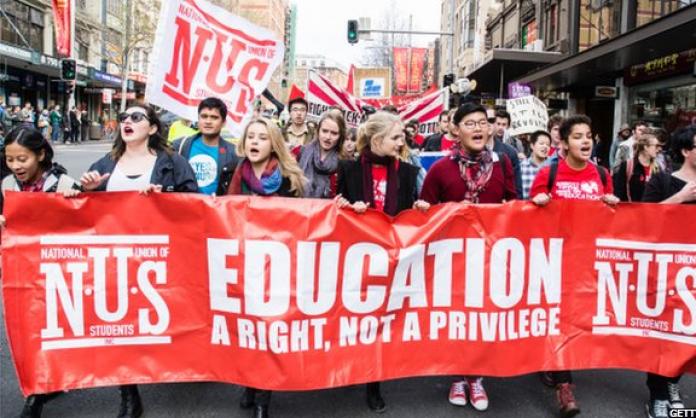Students are facing yet another attack from the federal government. If the Liberals pass their latest education package, announced Monday by education minister Simon Birmingham, fees will be increased and higher education funding will be slashed.
The government has proposed a 7.5 percent fee increase to be phased in from next year, which would increase the average cost of a degree by around $3,000. It is a major shift towards the user-pays, privatised system that the Liberals dream of – and that already exists in the US.
The student movement has to fight back against this right wing attack. Over the last three decades, we have taken hit after hit in the name of “fiscal responsibility”. If there were a fair share to pay, we have paid it with interest. All the while, the rich and the corporate world have been showered with tax cuts and tax breaks.
It's time for us to take to the streets. It's time for the politicians and vice-chancellors – most of whom benefited from government-funded, free education in their youth – to stop wanking on about KPIs and to take a break from checking their investment portfolios over long, boozy lunches. It's time for them to start listening to students.
Our fees are the highest they have ever been, and have risen dramatically since being introduced in the late 1980s. Today, a university degree costs, on average, two-and-a-half times more than in 1991. The cost of being a student has also increased. Australia has one of the highest rates of students in work in the world – 62.4 percent, according to the 2011 census. It’s not difficult to see why.
Successive governments have raised Centrelink eligibility requirements and decreased payments. Most recently, the Liberal government and the Labor Party scrapped start-up scholarships. Students are also facing high rents and often work low-wage jobs.
In addition to a huge fee increase, the government is proposing a $2.8 billion funding cut. If passed, this will be the single biggest funding cut to Australian universities in history and will degrade the quality of our education.
The government plan comes on top of existing cutbacks. Campuses across the country have been introducing “restructures” that have resulted in unprecedented numbers of staff redundancies, increased class sizes, more online courses and a reduction in the number of speciality units.
The move to a trimester system at many universities is an example. At UNSW, it will result in around 400 job cuts, a substantial reduction in face-to-face learning time and will enable the university to churn through more students more quickly.
A funding cut of $2.8 billion will give the universities further excuse to corporatise and privatise their operations. The government claims that the cut is desirable because the amount of money from government funding that universities have spent on teaching and learning has decreased from 94 percent to 85 percent since 2010. This is a profoundly cynical argument.
The reason less public money is being spent on teaching and learning is because university administrations have been given licence to run educational institutions like private businesses.
Higher education is the third most profitable export industry in Australia. Last year alone, profits increased by 17 percent. Universities have huge operating budgets and increasingly are making substantial corporate investments. They are also lining the pockets of their top executives – many vice-chancellors are on salaries of well over $1 million.
The government has made no attempt to regulate the way in which taxpayers’ money is spent by these cretins. On the contrary, it has made it clear that the ultimate aim is deregulation.
If the Liberals get this cut through, it will not lead to pay cuts for executives or reductions in private investments. It will be felt exclusively by students and staff.
In addition to demanding that students pay more for less, Turnbull and Birmingham’s education package includes changes to the rate and time at which HECS loans are repaid. The amount someone needs to earn per year before beginning to make repayments on their HECS debt will be reduced from $55,000 to $42,000.
HECS debt will also be pegged to the CPI. Wealthier graduates, who can repay their debts sooner, will pay less than those who need to pay them off over a longer period. And for most people, it will take longer: in 1986, it took graduates an average of one year to find a full time job. Today it takes 4.7 years on average.
Students and staff need to respond with action.
After the failure of former prime minister Tony Abbott and former education minister Christopher Pyne to push through huge attacks on students in 2014, the government tried to take the heat out of the issue by installing an inanimate carbon rod, Simon Birmingham, into the education portfolio. Now the Liberals have come back for round two. And Birmingham is living proof that there is no such thing as a benign conservative.
We cannot look to the parliament, and in particular the cross-bench, to save higher education. Pauline Hanson has already announced her intention to support the package.
When the Liberals first announced their cuts in 2014, they had the support of the cross-bench. It was not until we organised protests on the streets and on our campuses that the balance began to shift.
We need to do that again.
The National Union of Students is holding a national day of protest against the budget in cities across Australia on 17 May.









